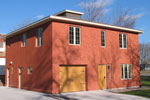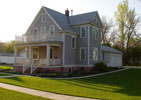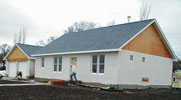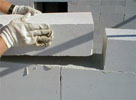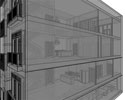Autoclaved Aerated Concrete (AAC)
AAC was developed in Sweden in the early 20th century. Josef Hebel began commercial production in Germany in the 1940’s. It is widely used in Europe, making up over 50 percent of residential construction, and is quickly gaining market share in Australia and Asia. Production plants are currently operating in over 50 countries. (For a list of AAC manufactures and distributors, visit the links page.) AAC has been slow to catch on in the U.S. because of the availability of inexpensive, high quality lumber and market inertia. However, as availability falls and prices rise for quality wood products, AAC is becoming economically competitive.
AAC is made with cement, lime, water, sand, and aluminum paste. The aluminum reacts with the alkaline content of cement and lime, creating millions of tiny evenly dispersed bubbles. The concrete mixture is poured in large pans and allowed to partially harden. After which it is cut into precise blocks and cured with steam and pressure; a process called autoclaving. The autoclaving cuts the length of time for the AAC to reach full compressive strength from the typical 29 days, to just hours.
The physical properties of AAC and its manufacturing process make it an ideal building material for numerous reasons. It can be used as load bearing walls and floors for buildings up to six stories in height. It is also an excellent partition wall material when fire and sound transmission are of concern.
Some of the major benefits of building with AAC are:
- Energy-Efficient
- Fire Resistant
- Sound Absorbent
- Weather Resistant
- Long-Lasting
- Environmentally Sound
- Pest Resistant
- Easy to Use
- Versatile
- Lightweight
Energy efficiency:
- The mass of the concrete combined with the trapped air, provide excellent insulation without the need of traditional foam or fiberglass.
- The solid AAC wall prevents air infiltration (i.e. drafts) and eliminates thermal bridging of studs, both of which are significant sources of energy loss in traditional buildings.
- AAC uses significantly less raw material per unit of output, thus reducing manufacturing energy use. The millions of tiny bubbles produce a concrete that is only about one fifth of the weight of conventional concrete. This means that five times as much building material is produced as compared to conventional concrete.
Safety:
- A standard eight-inch thick AAC wall has a minimum four-hour fire rating, ASTM #.
- AAC is made of inert, non-toxic materials. Thus it does not give off formaldehydes and other VOC’s, which are common in plywoods, paints and synthetic building materials.
- AAC does not contain organic material thus it can not rot and mold like wood.
- Insects and other pests can not hide in AAC walls because its tiny air bubbles are cellular, meaning they are not connected together and thus do not form passageways. This is in sharp contrast to foam insulated concrete forms, ISP’s, which contain many potential soft passageways.
Comfort:
- AAC buildings have uniform, consistent temperatures because of the insulting properties of thermal mass and the prevention of air infiltration, i.e. drafts.
- AAC buildings are quiet due to the mass and cellular structure of AAC walls and floors. This gives it STC ratings of 44 to 50 depending on finishing materials. Furthermore, AAC is so good at blocking noise it is used for sound barrier walls along highways.
- No chemical odors.
Environmentally Sound:
- Uses less energy during manufacturing.
- Uses less energy during the life of the building.
- Contains no toxic chemicals.
- 100 percent recyclable. Can be ground up and mix back into new concrete.
- Requires less maintenance over time, thus reducing its lifecycle environmental impacts.
- Can be manufactured with fly ash from coal power plants, eliminating the need to landfill the fly ash.
Affordable:
- AAC costs roughly $12.00 per square foot of finished exterior wall (includes: block, mortar, stucco, plaster and labor, excludes shipping costs). The walls of a typical 2,000 square foot house will cost roughly $40,000 with transportation included. A wood house costs about $______.
- Labor costs are dramatically reduced because fewer components need to be assembled on site. In some cases the labor costs can be reduced by 40 percent. Labor costs today makes up an average 30 percent of the cost of building a single family house.
